If you’ve ever fixed bicycles, motorcycles, or any appliance with cross-head screws, you know how frustrating it gets when your screwdriver keeps slipping out, especially when trying to loosen a stuck screw. It doesn’t have to be like that. Let’s dive into this problem.
In this post, I’ll explain how to find a cross-head (Phillips) screwdriver that doesn’t slip out when unscrewing a tight screw. I will do that first, briefly. Then comes some history and standards explanation (including JIS) to provide a universal way of recognizing the good, well-fitting screwdrivers – and clarify what it’s all about.
In a separate article, I explained all the hex-bit size standards and types.
TL/DR
I had a problem with some cross-tipped screwdrivers more easily slipping and damaging screws on Japanese bicycles and motorcycles I work on.
In chapter 4, you can find a list of screwdrivers that work well (what I use, what works for me – and my friends).
In the first three chapters, I’ve explained why some screwdrivers suck and which types of cross-tipped screwdrivers exist (people often mix those, use the wrong screwdriver, mess up the screw, and then it’s a headache).
1. Good cross-head screwdriver
The goal of this article (and my research for it) was to help myself find a screwdriver that fits well and doesn’t cam-out. In other words: how can I tell, before trying (and buying), if a screwdriver will work properly with a bicycle, motorcycle and other cross-head screws?
Those who wish to know how I chose this screwdriver can read the following chapters. Still, for those who just want to know which screwdriver has worked very well for me, on both the American Phillips and on Japanese (bicycle and motorcycle) cross-headed screws, this is it (providing Amazon affiliate links for screwdriver pictures and price-comparison):
Wera Kraftform Stainless 3350 PH 2

Picture 1
Do you have to buy this one, or are there other good ones? Well, I’ve got some good and some bad news – which one do you want to read first? 🙂
- The Good news: yes, there are more than one manufacturer (and model) of good quality cross-head screwdrivers (some more recommendations are in Chapter 4).
- The Bad news: it’s not simple figuring those out, and trying one out is often the only really safe way to confirm eventually. Will do my best to explain it in this article.
Before theory, here is my practical demonstration of the problem and how the screwdriver shown above solves it:
The rest of this post is a rather detailed explanation of the crossed-head screwdriver topic, but with no final answer for now, just a few practical examples.
Took me a lot of time to figure this out and get all the data. Yet, take this article as: “to the best of my knowledge”. Any additions or corrections are welcome.
2. Screwdriver development heroes
“Not all the heroes wear capes” 🙂
– BikeGremlin shower thoughts
Starting with a bit of history. Just as little as necessary to understand the current chaos with cross-head screwdrivers. Don’t be afraid – it won’t hurt. 🙂
Standards, specifications and dimensions are discussed in the 3rd chapter.
2.1. Phillips screwdrivers
You might have heard of these, they are also known as “cross-recess”, “cross-head”, or “cross-point”. How did they come to be, and what is the main problem with them?
A man named John P. Thompson invented (and patented under US Pat. No. #1,908,080) a “recessed cruciform screw” in 1932. In 1933 he also patent-protected a matching screwdriver. But he was probably as good a salesman and capitalist as I am, so he couldn’t get anyone to produce screws and screwdrivers with this patent. 🙂
Then came Henry F. Phillips, who bought the design/patent in 1935 and refined it (the final version patent being US. #2,046,840). A year before that, he had started the “Phillips Screw Company” ( 🙂 ). He understood the advantage of this patent:
Unlike slotted screws of the time, Phillips allowed one to quickly place a screwdriver in the screw – with the screwdriver automatically sliding in place and self-centring. We might take that for granted today, but at the time, it was revolutionary. Just try using a battery-powered screwdriver on a slotted head screw (with a flat-blade tip) to see what I mean.
What are the problems with Phillips?
- Inefficient ways of manufacturing such complicated screws and bits – for the 30s of the XX century. This problem was overcome by the “American Screw Company of Providence”, Rhode Island, and after that, Phillips became widely used.
- Just as easily as a Phillips screwdriver engages with a screw, it also easily disengages. I’ll explain the implications of this in the next paragraph.
Production lines in the 30s (XX century), especially in the growing automobile industry, did have electric screwdrivers, but very few of those had the option of setting up the tightening torque. The Phillips design allowed such screwdrivers to cam out before exerting too much tightening torque on the screw (and damaging the material, or the screw). The problem with this, that no mass-producing capitalist would care about, is when such assemblies need to be disassembled and serviced – as anyone dealing with stuck, rusted Phillips screws can attest.
Many people claim that the easy cam-out was designed on purpose to prevent over-tightening. I couldn’t find any evidence to support that – only evidence supporting the self-centring easy slide-in function could be found.
This leads us to another story – Japan: small country, small people, small machines, yet they are the best! 🙂
2.2. JIS (Japanese Industrial Standard) screwdrivers
“Everything done hastily has to be done again – slowly”
– My late father, Živojin Novović, quite a competent engineer
Samurai have correctly concluded that while screwdriver self-alignment is a great thing, saving split-seconds while inserting it is not worth the headaches with easy cam-out and problems with later disassembling/servicing. So in 1958, they made a very similar design, but with “sharper edges,” to put it that way.
Differences between JIS and Phillips screws and screwdrivers are difficult to tell with the naked eye, but are easily noticed when using a screwdriver!
JIS screwdriver holds well both JIS and Phillips screws.
While a Phillips screwdriver easily slips out of Phillips screws and does even worse with JIS screws.
Read again, and memorize the two sentences above. That is the essence of the problem’s solution. I’ll repeat it with different wording:
JIS screwdrivers work better with both JIS and Phillips screws!
2.3. The difference between Phillips and JIS screwdrivers
Before a more detailed story about the standards, I’ll briefly explain the main differences. Starting with a picture:
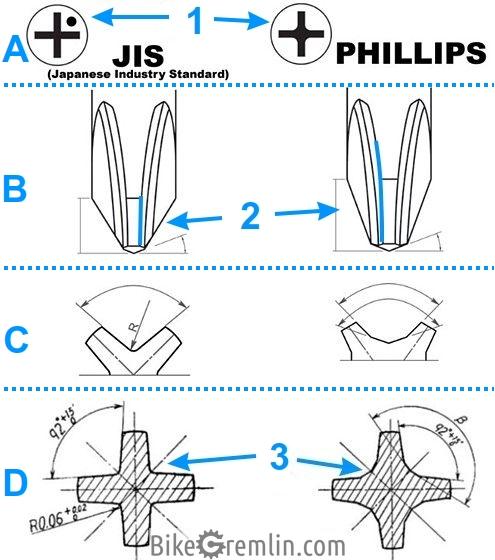
Picture 2
(A) in the picture above shows the difference in the way screws are marked, though not all the JIS screws are marked with such a dot (1).
(B) shows how Phillips has a very slight curve (2) – not really visible to the naked eye (exaggerated in the drawing), but it makes the difference when force is applied, “helping” the screwdriver slip out (and in).
(C) and (D) show tip cross-section when looking straight at the tip. Philips has a slightly larger radius (3), which prevents it from fitting properly into JIS screws.
I’ll repeat: these differences are difficult to spot with the naked eye – all those screwdrivers look pretty much the same.
3. Standards of popular cross-tipped screwdrivers
Now I’ll list the most widely used types, first the obsolete, then the current standard ones, sorted chronologically, so it can be understood more easily.
3.1. Phillips – US standard
Already mentioned in Chapter 2.1, where all its pros and cons are explained.
- It is noted by the letters “PH”,
- followed by a size-code: #0000, #000, #00, #0 (very small, jeweler-sized ones), #1, #2, #3, and #4 (super large, for heavy machinery).

Picture 3
- From 1961 to 2006, it was defined by German standard DIN 5260-2, when the ISO standard superseded it.
- Now it is defined only by (DIN) ISO 8764-1 PH (standard designated in 2004) and (DIN) ISO 8764-2 PH.
(Not very) fun fact: DIN stands for “Deutsches Institut fur Normung” (German Institute for Standardization).
Brief reminder: slips relatively easily out of even the matching Phillips screws, while it’s even worse with the others (JIS and Pozidriv). Phillips screwdrivers suck – plain and simple.
3.2. JIS – Japanese standard
Its history is explained in Chapter 2.2.
It used to be defined by the Japanese JIS B 4633, but in 2008 that standard was declared obsolete, and now it is only defined by ISO 8764-1 PH, and ISO 8764-2 PH. Yes, the same ones used for Phillips screwdrivers! See now where all the confusion comes from? They used to be marked like this, differently:
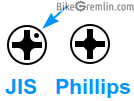
Picture 4
Update, June 2023:
Klaus shared some interesting information and links in his comments on this article (Klaus’ comments on JIS). Based on that info, JIS has not been made obsolete, but most screwdriver manufacturers have stopped marking their tools using JIS and started marking their tools using ISO and DIN standards – i.e. the screwdrivers are marked as Phillips.
As I explained in previous chapters, JIS screwdrivers are just better in practically every way compared to Phillips screwdrivers. But how to buy a JIS screwdriver when they are noted the same as Phillips ones? Are they all the same now?
The answer to the second question is: “No, they are not the same”. What about the first question? That’s a bit more difficult. I’ll try my best to answer it, but first, a short note on a standard (two, in fact) that often gets confused with the above-noted standards:
3.3. Pozidriv and Supadriv
Often gets confused with Phillips, at least in Serbia, so it’s worth mentioning. Pozidriv is a European attempt to solve the cam-out problem of Phillips screwdrivers (and screws), patented in 1962 by a British company “GKN Screws and Fasteners”. Later perfected to the Supadriv standard.
- Both Pozidriv and Supadriv are noted by the letters “PZ”,
- followed by a size-code: #0, #1, #2, #3, #4, and #5.
The only difference is that Pozidriv’s “icon” (to call it that) has two more identification “ticks”:

Picture 5
Pozidriv screwdriver will fit any Supadrive screw and vice-versa. However, the Supadriv screwdriver, when used with a Supadriv screw, allows for using the screwdriver at a (slight) angle without risking it coming out when higher torque is applied.
On the other hand: no other screwdriver will fit Pozidriv/Supadriv screws – it will slip out and damage them. So pay attention when you come across these types of screws, and use appropriate screwdrivers:

Note the small lines on the Pozidriv screws between the large cross-flats – that’s how they are easily recognized
Picture 6

Picture 7
A technical drawing of the Pozidriv standard screwdriver tip:
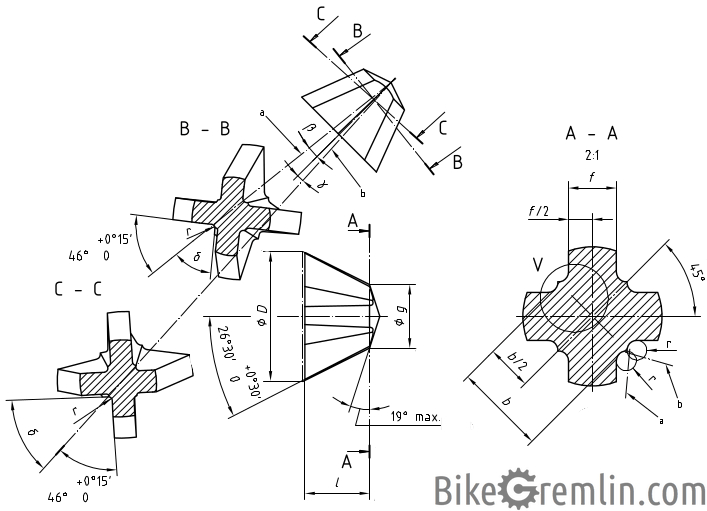
Picture 8
On paper, it differs a lot from Phillips, but in real life, people often confuse the two – which results in damaged screws that can no longer be unscrewed even using a matching screwdriver.
3.4. Summary – what you can mix with what
To briefly summarize, at the cost of being repetitive, here’s a list of combinations that work well together (other combinations should be avoided):
- Phillips screws: use JIS (preferably, they’ll work better) or Phillips screwdrivers.
- JIS screws: use JIS screwdrivers. Phillips screwdrivers won’t fit very well, so use them with great caution (avoid using them if possible).
- Pozidriv screws: use Pozidriv (preferably) or Supadriv screwdrivers.
- Supadriv screws: use Supadriv (preferably) or Pozidriv screwdrivers.
4. How can I find a good Phillips/JIS screwdriver?
After a brief Pozidriv/Supadriv digression, how does one find a good screwdriver for Phillips and/or JIS screws? In Chapter 3.2. I explained how JIS was discontinued as a standard in 2008, so now there is only ISO 8764. In other words: almost no manufacturers today make and sell screwdrivers noted as “JIS”, only “Phillips, ISO 8764-1, 2”. Some might (also) mention “DIN 5260-PH”, but no “JIS”.
Then how can you tell if a Phillips is one that works well with JIS screws and doesn’t easily slip out of Phillips screws?
It still boils down to trial and error. I intend to run this article with local tool companies and suppliers to see if they have a more universal solution. Until then, I can only recommend what I have personally tested and a few other ones recommended by many mechanics (but I haven’t tested personally):

I use this one – it’s my favourite cross-tip screwdriver; both the handle and the tip are awesome 🙂
Picture 9

Amazon affiliate link – I haven’t tested this model
Update 2023:
I got a set of these screwdrivers. They are good.
The tips are no worse (nor better) than the above-shown Wera, but for my hands, the Wera’s handle fits better, especially when I need to apply more torque for more than a few turns. I love the serrated blade, though – for easier fast spinning when the screw is loose 🙂
Picture 10
Vessel also makes “manual impact” JIS screwdrivers for really stuck bolts (Amazon affiliate link):
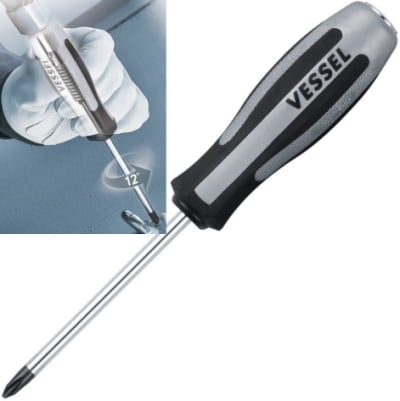
Picture 11
While I haven’t tested the above-shown Vessel impact screwdriver, I love the below-shown set by Wera. It’s an impact screwdriver that can be “locked” to work as a striking screwdriver (my video explaining screwdriver types). All the “PH” bits work very well with screws on Japanese motorcycles and bicycle parts (though it’s 25 Nm of torque on impact, so not for the heavy-duty automobile stuff).
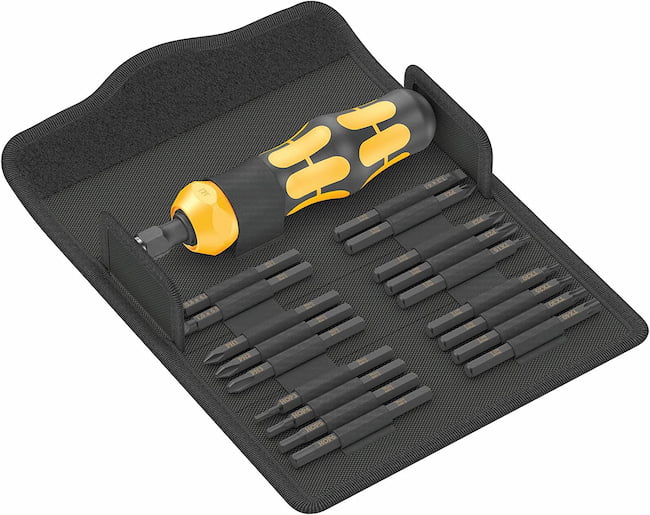
Picture 12
5. Sources
- Wikipedia page on screwdriver standards
- Vessel screwdriver manufacturer’s PDF presentation
- ISO 8764-1 standard preview – pdf
The existing comments posted under this article (questions and answers) have been moved to this BikeGremlin forum thread:
https://www.bikegremlin.net/threads/phillips-jis-and-pozidriv-screwdrivers-explained-article-comments.126/
Last updated:
Originally published:

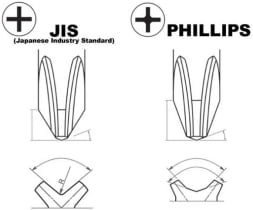
My understanding is that the ISO 8764 standard tries to unify the Phillips and JIS drivers into one universal driver that is supposed to work equally well with both types of screws. It does, but better for Phillips and a worse for JIS. The whole situation with cross head screws seems to be a huge trash fire.